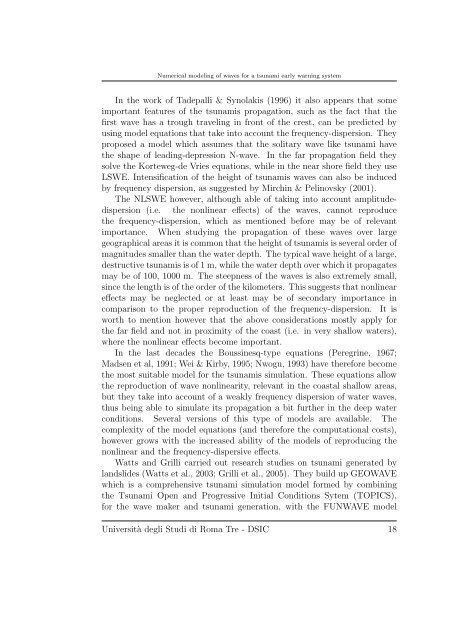Numerical modeling of waves for a tsunami early warning system
Numerical modeling of waves for a tsunami early warning system
Numerical modeling of waves for a tsunami early warning system
Create successful ePaper yourself
Turn your PDF publications into a flip-book with our unique Google optimized e-Paper software.
<strong>Numerical</strong> <strong>modeling</strong> <strong>of</strong> <strong>waves</strong> <strong>for</strong> a <strong>tsunami</strong> <strong>early</strong> <strong>warning</strong> <strong>system</strong><br />
In the work <strong>of</strong> Tadepalli & Synolakis (1996) it also appears that some<br />
important features <strong>of</strong> the <strong>tsunami</strong>s propagation, such as the fact that the<br />
first wave has a trough traveling in front <strong>of</strong> the crest, can be predicted by<br />
using model equations that take into account the frequency-dispersion. They<br />
proposed a model which assumes that the solitary wave like <strong>tsunami</strong> have<br />
the shape <strong>of</strong> leading-depression N-wave. In the far propagation field they<br />
solve the Korteweg-de Vries equations, while in the near shore field they use<br />
LSWE. Intensification <strong>of</strong> the height <strong>of</strong> <strong>tsunami</strong>s <strong>waves</strong> can also be induced<br />
by frequency dispersion, as suggested by Mirchin & Pelinovsky (2001).<br />
The NLSWE however, although able <strong>of</strong> taking into account amplitudedispersion<br />
(i.e. the nonlinear effects) <strong>of</strong> the <strong>waves</strong>, cannot reproduce<br />
the frequency-dispersion, which as mentioned be<strong>for</strong>e may be <strong>of</strong> relevant<br />
importance. When studying the propagation <strong>of</strong> these <strong>waves</strong> over large<br />
geographical areas it is common that the height <strong>of</strong> <strong>tsunami</strong>s is several order <strong>of</strong><br />
magnitudes smaller than the water depth. The typical wave height <strong>of</strong> a large,<br />
destructive <strong>tsunami</strong>s is <strong>of</strong> 1 m, while the water depth over which it propagates<br />
may be <strong>of</strong> 100, 1000 m. The steepness <strong>of</strong> the <strong>waves</strong> is also extremely small,<br />
since the length is <strong>of</strong> the order <strong>of</strong> the kilometers. This suggests that nonlinear<br />
effects may be neglected or at least may be <strong>of</strong> secondary importance in<br />
comparison to the proper reproduction <strong>of</strong> the frequency-dispersion. It is<br />
worth to mention however that the above considerations mostly apply <strong>for</strong><br />
the far field and not in proximity <strong>of</strong> the coast (i.e. in very shallow waters),<br />
where the nonlinear effects become important.<br />
In the last decades the Boussinesq-type equations (Peregrine, 1967;<br />
Madsen et al, 1991; Wei & Kirby, 1995; Nwogu, 1993) have there<strong>for</strong>e become<br />
the most suitable model <strong>for</strong> the <strong>tsunami</strong>s simulation. These equations allow<br />
the reproduction <strong>of</strong> wave nonlinearity, relevant in the coastal shallow areas,<br />
but they take into account <strong>of</strong> a weakly frequency dispersion <strong>of</strong> water <strong>waves</strong>,<br />
thus being able to simulate its propagation a bit further in the deep water<br />
conditions. Several versions <strong>of</strong> this type <strong>of</strong> models are available. The<br />
complexity <strong>of</strong> the model equations (and there<strong>for</strong>e the computational costs),<br />
however grows with the increased ability <strong>of</strong> the models <strong>of</strong> reproducing the<br />
nonlinear and the frequency-dispersive effects.<br />
Watts and Grilli carried out research studies on <strong>tsunami</strong> generated by<br />
landslides (Watts et al., 2003; Grilli et al., 2005). They build up GEOWAVE<br />
which is a comprehensive <strong>tsunami</strong> simulation model <strong>for</strong>med by combining<br />
the Tsunami Open and Progressive Initial Conditions Sytem (TOPICS),<br />
<strong>for</strong> the wave maker and <strong>tsunami</strong> generation, with the FUNWAVE model<br />
Università degli Studi di Roma Tre - DSIC 18

















